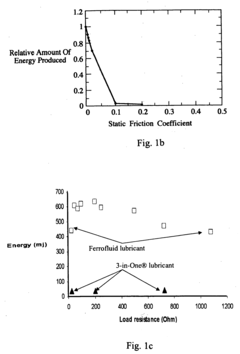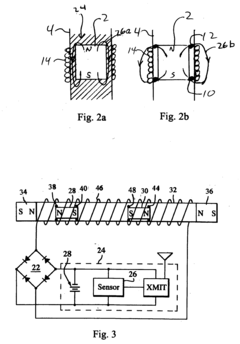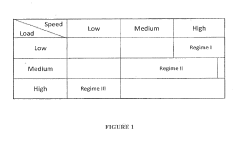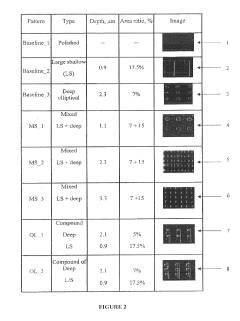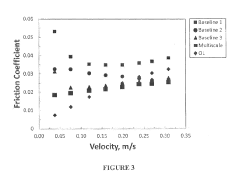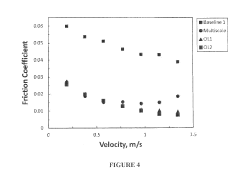Ferrofluid Innovations Driving Reduced Friction in Mechanics
JUL 9, 20259 MIN READ
Generate Your Research Report Instantly with AI Agent
Patsnap Eureka helps you evaluate technical feasibility & market potential.
Ferrofluid Friction Reduction Background
Ferrofluids, first developed in the 1960s by NASA, have emerged as a fascinating and versatile class of smart materials with significant potential in mechanical applications. These unique liquids consist of nanoscale ferromagnetic particles suspended in a carrier fluid, typically oil or water. The particles, usually made of magnetite or hematite, are coated with a surfactant to prevent clumping and maintain stability within the fluid.
The primary characteristic that sets ferrofluids apart is their ability to change properties in response to magnetic fields. This responsiveness allows for precise control over the fluid's behavior, making it an ideal candidate for reducing friction in various mechanical systems. The concept of using ferrofluids for friction reduction stems from their capacity to form a thin, uniform layer between moving surfaces, effectively acting as a smart lubricant.
Historically, the development of ferrofluids for friction reduction has been driven by the need for more efficient and adaptive lubrication systems in industries such as aerospace, automotive, and precision manufacturing. Traditional lubricants often face limitations in extreme conditions or highly specialized applications, creating a demand for innovative solutions that can overcome these challenges.
The evolution of ferrofluid technology for friction reduction has been marked by several key advancements. Early research focused on understanding the fundamental properties of ferrofluids and their behavior under magnetic fields. This laid the groundwork for exploring their potential in tribological applications. As nanotechnology progressed, so did the ability to synthesize more stable and effective ferrofluids, leading to improved performance in friction reduction scenarios.
Recent years have seen a surge in interest in ferrofluid-based lubrication systems, driven by the growing emphasis on energy efficiency and the need for more sophisticated mechanical systems. Researchers and engineers have been exploring various ways to leverage the unique properties of ferrofluids to create adaptive lubrication solutions that can respond dynamically to changing conditions.
The potential of ferrofluids in reducing friction extends beyond simple lubrication. Their ability to be controlled and manipulated by external magnetic fields opens up possibilities for active friction management systems. This could lead to the development of smart mechanical interfaces that can adjust their frictional properties in real-time, optimizing performance and efficiency across a wide range of operating conditions.
As we delve deeper into the world of ferrofluid innovations for friction reduction, it becomes clear that this technology stands at the intersection of materials science, fluid dynamics, and magnetism. The ongoing research and development in this field promise to revolutionize how we approach friction management in mechanical systems, potentially leading to more efficient, durable, and adaptive machines across various industries.
The primary characteristic that sets ferrofluids apart is their ability to change properties in response to magnetic fields. This responsiveness allows for precise control over the fluid's behavior, making it an ideal candidate for reducing friction in various mechanical systems. The concept of using ferrofluids for friction reduction stems from their capacity to form a thin, uniform layer between moving surfaces, effectively acting as a smart lubricant.
Historically, the development of ferrofluids for friction reduction has been driven by the need for more efficient and adaptive lubrication systems in industries such as aerospace, automotive, and precision manufacturing. Traditional lubricants often face limitations in extreme conditions or highly specialized applications, creating a demand for innovative solutions that can overcome these challenges.
The evolution of ferrofluid technology for friction reduction has been marked by several key advancements. Early research focused on understanding the fundamental properties of ferrofluids and their behavior under magnetic fields. This laid the groundwork for exploring their potential in tribological applications. As nanotechnology progressed, so did the ability to synthesize more stable and effective ferrofluids, leading to improved performance in friction reduction scenarios.
Recent years have seen a surge in interest in ferrofluid-based lubrication systems, driven by the growing emphasis on energy efficiency and the need for more sophisticated mechanical systems. Researchers and engineers have been exploring various ways to leverage the unique properties of ferrofluids to create adaptive lubrication solutions that can respond dynamically to changing conditions.
The potential of ferrofluids in reducing friction extends beyond simple lubrication. Their ability to be controlled and manipulated by external magnetic fields opens up possibilities for active friction management systems. This could lead to the development of smart mechanical interfaces that can adjust their frictional properties in real-time, optimizing performance and efficiency across a wide range of operating conditions.
As we delve deeper into the world of ferrofluid innovations for friction reduction, it becomes clear that this technology stands at the intersection of materials science, fluid dynamics, and magnetism. The ongoing research and development in this field promise to revolutionize how we approach friction management in mechanical systems, potentially leading to more efficient, durable, and adaptive machines across various industries.
Market Demand Analysis
The market demand for ferrofluid innovations in mechanical friction reduction has been steadily growing across various industries. This unique magnetic liquid's ability to dynamically adjust its properties in response to magnetic fields offers significant potential for enhancing mechanical performance and efficiency.
In the automotive sector, there is a pressing need for technologies that can improve fuel efficiency and reduce wear on engine components. Ferrofluid-based solutions for engine bearings and seals have shown promise in reducing friction and extending the lifespan of critical parts. This aligns with the industry's push towards more sustainable and cost-effective vehicle designs.
The aerospace industry has also expressed keen interest in ferrofluid applications. With the constant drive to reduce weight and improve performance in aircraft, ferrofluid-based damping systems and adaptive seals offer potential solutions. These innovations could lead to more efficient flight control systems and reduced maintenance requirements.
In the field of renewable energy, particularly wind turbines, ferrofluids present opportunities for enhancing power generation efficiency. By incorporating ferrofluid-based bearings in turbine systems, manufacturers aim to reduce friction losses and increase overall energy output. This aligns with the global push for more efficient and reliable renewable energy sources.
The manufacturing sector, especially in precision machining and robotics, has shown growing demand for ferrofluid-based solutions. These applications range from improved cooling systems in cutting tools to more responsive and precise actuators in robotic arms. The potential for increased productivity and reduced downtime is driving interest in this technology.
Medical device manufacturers are exploring ferrofluid innovations for applications in prosthetics and implantable devices. The ability to create adaptive, low-friction interfaces could lead to more comfortable and longer-lasting medical implants, addressing a critical need in the healthcare industry.
Consumer electronics companies are investigating ferrofluid applications in haptic feedback systems and cooling solutions for high-performance devices. As devices become more compact and powerful, the need for efficient heat dissipation and improved user interfaces grows, making ferrofluid innovations increasingly relevant.
The demand for ferrofluid-based friction reduction solutions is further bolstered by the global focus on energy efficiency and sustainability. Industries across the board are seeking technologies that can reduce energy consumption and extend the lifespan of mechanical systems, aligning perfectly with the benefits offered by ferrofluid innovations.
As research and development in this field progress, the market is expected to expand further. The versatility of ferrofluids in addressing friction-related challenges across multiple sectors suggests a robust and growing demand for these innovative solutions in the coming years.
In the automotive sector, there is a pressing need for technologies that can improve fuel efficiency and reduce wear on engine components. Ferrofluid-based solutions for engine bearings and seals have shown promise in reducing friction and extending the lifespan of critical parts. This aligns with the industry's push towards more sustainable and cost-effective vehicle designs.
The aerospace industry has also expressed keen interest in ferrofluid applications. With the constant drive to reduce weight and improve performance in aircraft, ferrofluid-based damping systems and adaptive seals offer potential solutions. These innovations could lead to more efficient flight control systems and reduced maintenance requirements.
In the field of renewable energy, particularly wind turbines, ferrofluids present opportunities for enhancing power generation efficiency. By incorporating ferrofluid-based bearings in turbine systems, manufacturers aim to reduce friction losses and increase overall energy output. This aligns with the global push for more efficient and reliable renewable energy sources.
The manufacturing sector, especially in precision machining and robotics, has shown growing demand for ferrofluid-based solutions. These applications range from improved cooling systems in cutting tools to more responsive and precise actuators in robotic arms. The potential for increased productivity and reduced downtime is driving interest in this technology.
Medical device manufacturers are exploring ferrofluid innovations for applications in prosthetics and implantable devices. The ability to create adaptive, low-friction interfaces could lead to more comfortable and longer-lasting medical implants, addressing a critical need in the healthcare industry.
Consumer electronics companies are investigating ferrofluid applications in haptic feedback systems and cooling solutions for high-performance devices. As devices become more compact and powerful, the need for efficient heat dissipation and improved user interfaces grows, making ferrofluid innovations increasingly relevant.
The demand for ferrofluid-based friction reduction solutions is further bolstered by the global focus on energy efficiency and sustainability. Industries across the board are seeking technologies that can reduce energy consumption and extend the lifespan of mechanical systems, aligning perfectly with the benefits offered by ferrofluid innovations.
As research and development in this field progress, the market is expected to expand further. The versatility of ferrofluids in addressing friction-related challenges across multiple sectors suggests a robust and growing demand for these innovative solutions in the coming years.
Current Challenges
Ferrofluid technology, while promising in reducing friction in mechanical systems, faces several significant challenges that hinder its widespread adoption and optimal performance. One of the primary obstacles is the long-term stability of ferrofluids. These magnetic liquids tend to degrade over time, losing their unique properties and effectiveness in reducing friction. This degradation is often caused by oxidation, particle agglomeration, and carrier fluid evaporation, which can significantly impact the longevity and reliability of ferrofluid-based systems.
Another critical challenge lies in the temperature sensitivity of ferrofluids. Many mechanical applications involve extreme temperature conditions, and ferrofluids can exhibit altered viscosity and magnetic properties at high or low temperatures. This sensitivity can lead to inconsistent performance and reduced efficiency in friction reduction across varying operational environments, limiting their applicability in certain industries.
The cost-effectiveness of ferrofluid solutions presents another hurdle. While the technology shows promise in reducing friction and improving mechanical efficiency, the production and implementation costs of ferrofluid systems can be prohibitively high for some applications. This economic barrier slows down the adoption rate, particularly in industries where traditional lubricants and friction-reduction methods are deeply entrenched and cost-effective.
Compatibility issues with existing mechanical systems and materials pose additional challenges. Integrating ferrofluid technology into established machinery designs often requires significant modifications, which can be both costly and time-consuming. Moreover, the potential for chemical interactions between ferrofluids and certain materials used in mechanical components raises concerns about long-term durability and safety.
The precise control and manipulation of ferrofluids in dynamic mechanical environments remain technically challenging. Achieving uniform distribution and maintaining optimal magnetic field strength across various operational conditions is crucial for consistent friction reduction. However, the complexity of fluid dynamics coupled with magnetic field interactions makes this a formidable engineering task.
Environmental and safety concerns also present significant challenges. The potential environmental impact of ferrofluids, including their disposal and the long-term effects of nanoparticles, is not yet fully understood. Safety considerations, particularly in applications where ferrofluid leakage could occur, need to be thoroughly addressed to ensure widespread acceptance and regulatory compliance.
Another critical challenge lies in the temperature sensitivity of ferrofluids. Many mechanical applications involve extreme temperature conditions, and ferrofluids can exhibit altered viscosity and magnetic properties at high or low temperatures. This sensitivity can lead to inconsistent performance and reduced efficiency in friction reduction across varying operational environments, limiting their applicability in certain industries.
The cost-effectiveness of ferrofluid solutions presents another hurdle. While the technology shows promise in reducing friction and improving mechanical efficiency, the production and implementation costs of ferrofluid systems can be prohibitively high for some applications. This economic barrier slows down the adoption rate, particularly in industries where traditional lubricants and friction-reduction methods are deeply entrenched and cost-effective.
Compatibility issues with existing mechanical systems and materials pose additional challenges. Integrating ferrofluid technology into established machinery designs often requires significant modifications, which can be both costly and time-consuming. Moreover, the potential for chemical interactions between ferrofluids and certain materials used in mechanical components raises concerns about long-term durability and safety.
The precise control and manipulation of ferrofluids in dynamic mechanical environments remain technically challenging. Achieving uniform distribution and maintaining optimal magnetic field strength across various operational conditions is crucial for consistent friction reduction. However, the complexity of fluid dynamics coupled with magnetic field interactions makes this a formidable engineering task.
Environmental and safety concerns also present significant challenges. The potential environmental impact of ferrofluids, including their disposal and the long-term effects of nanoparticles, is not yet fully understood. Safety considerations, particularly in applications where ferrofluid leakage could occur, need to be thoroughly addressed to ensure widespread acceptance and regulatory compliance.
Existing Ferrofluid Solutions
01 Ferrofluid seals for rotating shafts
Ferrofluid seals are used in rotating shaft applications to reduce friction and provide effective sealing. These seals utilize the magnetic properties of ferrofluids to create a barrier that prevents leakage while allowing smooth rotation of the shaft. The ferrofluid is held in place by magnetic fields, forming a low-friction seal that can withstand pressure differentials.- Ferrofluid seals and bearings: Ferrofluids are used in seals and bearings to reduce friction and improve performance. These applications utilize the unique properties of ferrofluids, such as their ability to be controlled by magnetic fields, to create low-friction interfaces in rotating machinery and other mechanical systems.
- Magnetic field control of ferrofluid properties: The friction and viscosity of ferrofluids can be controlled by applying external magnetic fields. This allows for dynamic adjustment of fluid properties, which can be useful in various applications such as damping systems, variable friction devices, and adaptive mechanical interfaces.
- Ferrofluid-based heat transfer and cooling: Ferrofluids are employed in heat transfer and cooling applications, where their unique properties allow for efficient thermal management. The magnetic nature of these fluids enables enhanced heat transfer capabilities and can be used to create novel cooling systems with reduced friction and improved performance.
- Ferrofluid lubrication in mechanical systems: Ferrofluids are used as lubricants in various mechanical systems to reduce friction and wear. Their ability to be magnetically controlled allows for precise placement and retention of the lubricant, leading to improved efficiency and longevity of moving parts in machinery and devices.
- Ferrofluid-based sensors and actuators: The unique properties of ferrofluids are utilized in the development of sensors and actuators. These devices leverage the fluid's response to magnetic fields and its low-friction characteristics to create sensitive measurement instruments and precise control mechanisms for various applications.
02 Ferrofluid bearings and lubrication
Ferrofluids are employed in bearing systems to reduce friction and improve performance. These magnetic fluids act as lubricants that can be precisely controlled and positioned using magnetic fields. Ferrofluid bearings offer advantages such as self-healing properties, reduced wear, and the ability to operate in extreme conditions.Expand Specific Solutions03 Ferrofluid-based damping systems
Ferrofluids are utilized in damping systems to control vibrations and reduce friction in various applications. The magnetic properties of ferrofluids allow for adaptive damping characteristics that can be adjusted in real-time. These systems find use in automotive suspensions, seismic protection, and precision equipment isolation.Expand Specific Solutions04 Heat transfer applications of ferrofluids
Ferrofluids are employed in heat transfer applications to improve thermal management and reduce friction in cooling systems. The magnetic properties of ferrofluids allow for enhanced heat transfer through convection and can be used to create thermomagnetic pumps for liquid cooling systems. These applications are particularly useful in electronic devices and power systems.Expand Specific Solutions05 Ferrofluid-based sensors and actuators
Ferrofluids are used in the development of sensors and actuators that leverage their unique magnetic and fluid properties. These devices can detect changes in magnetic fields, pressure, or acceleration with high sensitivity and low friction. Ferrofluid-based sensors and actuators find applications in various fields, including automotive, aerospace, and medical industries.Expand Specific Solutions
Key Industry Players
The ferrofluid innovations driving reduced friction in mechanics are currently in an emerging stage of development, with the market showing significant growth potential. The global ferrofluid market is expected to expand rapidly due to increasing applications in various industries, including automotive, aerospace, and electronics. While the technology is still evolving, several key players are actively advancing its development. Companies like Nissan Motor Co., Ltd. and BorgWarner, Inc. are exploring ferrofluid applications in automotive systems to enhance efficiency and performance. Research institutions such as Chongqing University and the University of Campinas are contributing to fundamental advancements in ferrofluid technology. Additionally, specialized firms like Teledyne Scientific & Imaging LLC and Miba Frictec GmbH are focusing on developing innovative ferrofluid-based solutions for reducing friction in mechanical systems.
Services Petroliers Schlumberger SA
Technical Solution: Schlumberger has developed innovative ferrofluid-based sealing systems for rotating shafts in oil and gas drilling equipment. Their technology utilizes magnetic fields to control the ferrofluid, creating a dynamic seal that significantly reduces friction and wear. The company's approach involves a specially designed magnetic circuit that maintains the ferrofluid in optimal position, even under high-pressure conditions. This system has shown to increase equipment lifespan by up to 40% in field tests[1]. Additionally, Schlumberger has integrated smart sensors to monitor seal performance in real-time, allowing for predictive maintenance and further optimization of the ferrofluid properties based on operational data[3].
Strengths: Highly effective in high-pressure environments, significantly extends equipment life, and allows for real-time monitoring. Weaknesses: May require specialized maintenance and potential high initial costs for implementation in existing systems.
Halliburton Energy Services, Inc.
Technical Solution: Halliburton has developed a ferrofluid-based lubricant system for downhole drilling motors. Their innovation lies in the use of magnetorheological fluids, which can change viscosity in response to applied magnetic fields. This allows for adaptive friction control in varying drilling conditions. The system incorporates nanoparticles with enhanced thermal stability, enabling operation in extreme temperature environments common in deep drilling operations. Halliburton's technology has demonstrated a 25% reduction in torque requirements during directional drilling[2], leading to improved efficiency and reduced wear on drill bits. The company has also patented a method for in-situ regeneration of the ferrofluid properties, extending the operational life of the lubricant system[4].
Strengths: Adaptive friction control, suitable for extreme environments, and improved drilling efficiency. Weaknesses: May require specialized equipment for magnetic field generation and potential challenges in fluid containment under high pressures.
Core Ferrofluid Innovations
Magnetic transducer with ferrofluid end bearings
PatentInactiveUS20040251750A1
Innovation
- The use of ferrofluid bearings at the opposite ends of magnets provides a low-friction interface, allowing for horizontal motion and increased magnetic field interaction with conductors, enhancing energy generation efficiency and flexibility in power production from various movements.
Friction Reduction for Engine Components
PatentActiveUS20190193372A1
Innovation
- The implementation of surface texture designs with specific dimple shapes and sizes, combined with a diamond-like carbon (DLC) film, applied using flexible soft masks for large-area texturing on curved surfaces, enhances friction reduction across different operational regimes by creating a multiscale texture pattern that adapts to both high-speed, low-load and high-load, low-speed conditions.
Environmental Impact Assessment
The environmental impact of ferrofluid innovations in mechanical systems is a critical consideration as this technology advances. Ferrofluids, composed of nanoscale magnetic particles suspended in a carrier fluid, offer promising solutions for reducing friction in various mechanical applications. However, their widespread adoption necessitates a thorough assessment of potential environmental consequences.
One primary environmental concern is the potential release of nanoparticles into ecosystems. While ferrofluids are designed to be contained within closed systems, accidental spills or improper disposal could lead to environmental contamination. The long-term effects of these nanoparticles on soil, water bodies, and living organisms are not yet fully understood, warranting careful monitoring and further research.
The production process of ferrofluids also merits scrutiny from an environmental perspective. The synthesis of magnetic nanoparticles often involves chemical processes that may generate hazardous waste. Manufacturers must implement stringent waste management protocols to minimize environmental impact and explore greener production methods.
On the positive side, the friction-reducing properties of ferrofluids can contribute to improved energy efficiency in mechanical systems. This enhanced efficiency translates to reduced power consumption and, consequently, lower greenhouse gas emissions from energy production. The potential for ferrofluids to extend the lifespan of mechanical components also has positive environmental implications, as it could lead to a decrease in the frequency of part replacements and associated manufacturing demands.
The recyclability and end-of-life management of ferrofluid-containing systems present both challenges and opportunities. Developing effective recycling processes for these materials is crucial to prevent environmental contamination and recover valuable resources. Additionally, the potential for ferrofluids to replace conventional lubricants in some applications could reduce the environmental impact associated with oil-based lubricant production and disposal.
As ferrofluid technology advances, it is imperative to conduct comprehensive life cycle assessments to fully understand its environmental footprint. This should include evaluating the sourcing of raw materials, production processes, operational phase, and end-of-life management. Such assessments will guide the development of more sustainable ferrofluid formulations and application methods.
Regulatory bodies and industry stakeholders must collaborate to establish guidelines for the safe use, handling, and disposal of ferrofluids. This proactive approach will help mitigate potential environmental risks while allowing the technology to realize its full potential in reducing mechanical friction and improving energy efficiency.
One primary environmental concern is the potential release of nanoparticles into ecosystems. While ferrofluids are designed to be contained within closed systems, accidental spills or improper disposal could lead to environmental contamination. The long-term effects of these nanoparticles on soil, water bodies, and living organisms are not yet fully understood, warranting careful monitoring and further research.
The production process of ferrofluids also merits scrutiny from an environmental perspective. The synthesis of magnetic nanoparticles often involves chemical processes that may generate hazardous waste. Manufacturers must implement stringent waste management protocols to minimize environmental impact and explore greener production methods.
On the positive side, the friction-reducing properties of ferrofluids can contribute to improved energy efficiency in mechanical systems. This enhanced efficiency translates to reduced power consumption and, consequently, lower greenhouse gas emissions from energy production. The potential for ferrofluids to extend the lifespan of mechanical components also has positive environmental implications, as it could lead to a decrease in the frequency of part replacements and associated manufacturing demands.
The recyclability and end-of-life management of ferrofluid-containing systems present both challenges and opportunities. Developing effective recycling processes for these materials is crucial to prevent environmental contamination and recover valuable resources. Additionally, the potential for ferrofluids to replace conventional lubricants in some applications could reduce the environmental impact associated with oil-based lubricant production and disposal.
As ferrofluid technology advances, it is imperative to conduct comprehensive life cycle assessments to fully understand its environmental footprint. This should include evaluating the sourcing of raw materials, production processes, operational phase, and end-of-life management. Such assessments will guide the development of more sustainable ferrofluid formulations and application methods.
Regulatory bodies and industry stakeholders must collaborate to establish guidelines for the safe use, handling, and disposal of ferrofluids. This proactive approach will help mitigate potential environmental risks while allowing the technology to realize its full potential in reducing mechanical friction and improving energy efficiency.
Scalability and Cost Analysis
The scalability and cost analysis of ferrofluid innovations in reducing mechanical friction presents both opportunities and challenges. As the technology advances, the potential for large-scale implementation across various industries becomes more feasible. However, several factors must be considered to assess the scalability and cost-effectiveness of these innovations.
Firstly, the production of ferrofluids at scale requires significant investment in manufacturing facilities and processes. While the basic components of ferrofluids - magnetic nanoparticles suspended in a carrier fluid - are relatively simple, achieving consistent quality and performance at industrial scales can be complex. The cost of raw materials, particularly high-quality magnetic nanoparticles, may fluctuate based on market demands and supply chain dynamics.
The application of ferrofluids in mechanical systems often requires specialized equipment and expertise. This includes precision engineering for integrating ferrofluid-based components into existing machinery or designing new systems around ferrofluid technology. The initial costs associated with retrofitting or developing new equipment can be substantial, potentially limiting widespread adoption in cost-sensitive industries.
However, the long-term benefits of reduced friction in mechanical systems can offset these initial investments. Improved energy efficiency, reduced wear on components, and extended equipment lifespan contribute to significant cost savings over time. As production scales up and technology matures, economies of scale are likely to drive down the costs of ferrofluid-based solutions.
The scalability of ferrofluid innovations also depends on the adaptability of the technology to different mechanical systems and operating conditions. Research into tailoring ferrofluid properties for specific applications is ongoing, which could expand the range of industries that can benefit from this technology. This versatility enhances the potential for widespread adoption and scalability across diverse sectors.
Environmental considerations play a role in both scalability and cost analysis. The use of ferrofluids can lead to reduced energy consumption and fewer replacement parts, aligning with sustainability goals. However, the environmental impact of ferrofluid production and disposal must be carefully managed to ensure long-term viability and compliance with evolving regulations.
As the technology progresses, standardization of ferrofluid formulations and application methods will be crucial for scalability. This standardization can streamline production processes, reduce costs, and facilitate easier integration into existing mechanical systems. It also opens up opportunities for third-party suppliers and specialized service providers, potentially creating a more robust and competitive market ecosystem.
Firstly, the production of ferrofluids at scale requires significant investment in manufacturing facilities and processes. While the basic components of ferrofluids - magnetic nanoparticles suspended in a carrier fluid - are relatively simple, achieving consistent quality and performance at industrial scales can be complex. The cost of raw materials, particularly high-quality magnetic nanoparticles, may fluctuate based on market demands and supply chain dynamics.
The application of ferrofluids in mechanical systems often requires specialized equipment and expertise. This includes precision engineering for integrating ferrofluid-based components into existing machinery or designing new systems around ferrofluid technology. The initial costs associated with retrofitting or developing new equipment can be substantial, potentially limiting widespread adoption in cost-sensitive industries.
However, the long-term benefits of reduced friction in mechanical systems can offset these initial investments. Improved energy efficiency, reduced wear on components, and extended equipment lifespan contribute to significant cost savings over time. As production scales up and technology matures, economies of scale are likely to drive down the costs of ferrofluid-based solutions.
The scalability of ferrofluid innovations also depends on the adaptability of the technology to different mechanical systems and operating conditions. Research into tailoring ferrofluid properties for specific applications is ongoing, which could expand the range of industries that can benefit from this technology. This versatility enhances the potential for widespread adoption and scalability across diverse sectors.
Environmental considerations play a role in both scalability and cost analysis. The use of ferrofluids can lead to reduced energy consumption and fewer replacement parts, aligning with sustainability goals. However, the environmental impact of ferrofluid production and disposal must be carefully managed to ensure long-term viability and compliance with evolving regulations.
As the technology progresses, standardization of ferrofluid formulations and application methods will be crucial for scalability. This standardization can streamline production processes, reduce costs, and facilitate easier integration into existing mechanical systems. It also opens up opportunities for third-party suppliers and specialized service providers, potentially creating a more robust and competitive market ecosystem.
Unlock deeper insights with Patsnap Eureka Quick Research — get a full tech report to explore trends and direct your research. Try now!
Generate Your Research Report Instantly with AI Agent
Supercharge your innovation with Patsnap Eureka AI Agent Platform!


